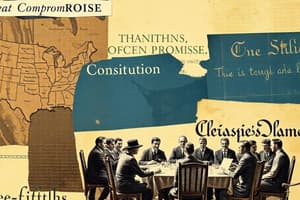Podcast
Questions and Answers
What is the Great Compromise?
What is the Great Compromise?
- Representation based on population only
- A plan that included only Northern states
- Equal representation for every state
- A combination of the Virginia and New Jersey Plans (correct)
What did the Three-Fifths Compromise establish regarding slave representation?
What did the Three-Fifths Compromise establish regarding slave representation?
Every five slaves would be counted as three individuals for representation.
What did the Commerce Compromise dictate about tariffs?
What did the Commerce Compromise dictate about tariffs?
Tariffs were only to be allowed on imports from foreign countries and not on exports from the U.S.
The Slave Trade Compromise allowed Congress to ban the importation of slaves immediately.
The Slave Trade Compromise allowed Congress to ban the importation of slaves immediately.
What system was established for the election of the President?
What system was established for the election of the President?
Flashcards are hidden until you start studying
Study Notes
Great Compromise
- Merged Virginia and New Jersey Plans to establish a bicameral legislature.
- Senate: Equal representation for each state, regardless of size.
- House of Representatives: Representation based on state population.
- Ensured agreement between larger and smaller states for legislative structure.
Three-Fifths Compromise
- Northern delegates opposed counting slaves for representation; Southern states wanted to count them.
- Resulted in every five slaves being counted as three individuals for apportioning representatives.
- Balanced interests of slaveholding Southern states and free Northern states in Congress.
Commerce Compromise
- Northern industrial states sought import tariffs to protect local goods; Southern agricultural states opposed export tariffs due to economic reliance on exports.
- Compromise allowed tariffs only on foreign imports, protecting Southern trade interests.
- Federal regulation of interstate commerce established, requiring two-thirds majority in the Senate for commerce legislation, benefiting Southern states.
Slave Trade Compromise
- Northern states aimed to end slave trade; Southern states deemed it essential for their economy.
- Agreement to postpone any ban on the importation of slaves until 1808.
- Included a fugitive slave law mandating Northern states return runaway slaves, catering to Southern demands.
Election of the President: The Electoral College
- Different views on presidential election led to concerns over an uninformed electorate.
- Alternatives included state Senate selections; ultimately led to the creation of the Electoral College.
- Electors in the Electoral College are allocated proportionally based on population, blending popular and indirect election methods.
Studying That Suits You
Use AI to generate personalized quizzes and flashcards to suit your learning preferences.




